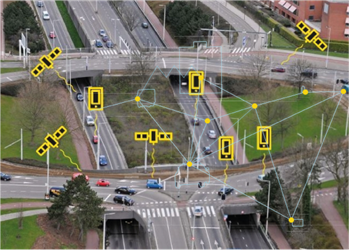Case study Floating Car Data for Minder Hinder projects
The Nationale Databank Wegverkeersgegevens (National Road Traffic Data Portal - NDW) has made floating car data available since 2017. Via the NDW, the authorities and projects can receive average speeds and travel times on specified routes. These data can be of added value for Minder Hinder (Less Disruption) projects, for example:
- Using real-time data for traffic management by such means as displaying current travel times on alternative routes on message trailers along the road or displaying current traffic flow for road users on a website or via an app.
- Using historical data for analyses and policy, for example by performing a good problem analysis and identifying promising mobility-influencing measures, but also by adjusting traffic measures when implementing a project based on monitoring and evaluation.
FCD are GPS movement-tracking data (from smartphones and in-car navigation systems, for example) that are transmitted over a communication network. The NDW is currently purchasing these from the service provider Be-Mobile. The NDW receives average speed data (every 60 seconds on road segments up to 50 metres) based on data from the Flitsmeister navigation app, among others. This normally yields around 1,000,000 average speeds per minute, which creates a nationwide traffic image. The NDW can convert these data into travel times on road journeys.
These travel times are also available on the NDW's open data site (http://opendata.ndw.nu/, in the file traveltime.xml.gz). Besides Be-Mobile's FCD, the NDW also has historical FCD from INRIX available, dating back to 2014.
Projects or road authorities can use this to create their own routes via an interface. An alternative for this is to submit a request by e-mail to mail@servicedeskndw.nu. If an external contractor starts working with the data, then you receive a form in which you can state what the data will be used for. This is necessary because the commissioning authority is responsible for the use of the data. The request for current data has a lead time of about two weeks (from request to delivery).
Background and purpose
The main reasons for a Minder Hinder project to use the NDW's FCD are:
- Savings can be made on more static and expensive roadside systems.
- Data can be gathered from multiple road authorities via the same system instead of via different systems for each road authority.
- The reach is much larger compared to traditional roadside systems.
- No complicated procurement and realisation process is required
so the system can be quickly deployed.
To summarise, the objectives of a project, such as traffic management or monitoring and evaluation, can be achieved more easily with FCD than without it. This is further explained below under 'Scope and effect'.
Scope and effect
There are currently over 26,000 FCD-based travel time journeys in the NDW's open data site. The NDW service is therefore already widely used, but this can still grow rapidly. The travel time information is now used in information-provision by projects and road authorities, in which countless road users are reached through travel time information on DRIPS, for example. Thanks to FCD, this can be done much more cheaply and flexibly than with registration plate cameras or Bluetooth receivers. There is no need to adjust anything on the road to use FCD: this saves installation and maintenance costs and disruption for the road user.
Points for consideration
- In order to guarantee the reliability of the data, it is only possible to calculate travel time if 60% of the segments of a route provide data. If no data are available on a segment (in the event of insufficient coverage by FCD sources), calculations will be made using the available data from other segments of the route.
- From a data perspective, the applicant may do anything with the data. Due to agreements between the market and the government regarding the dissemination of up-to-date traffic information, some restraint is desirable.
- By becoming a customer of the NDW, a data availability of 99.9% is guaranteed, including associated support via a service desk. A real-time system link can be set up to fully automate data delivery.
- If the applicant wants to do more with the data than disseminate or analyse travel times (such as more detailed traffic analyses), it is important to have knowledge of location reference. Location reference is all information related to a given datum, e.g. direction of travel, lane and parallel or main carriageway.
- If a project involves temporary or modified infrastructure, it is important to inform the NDW and/or Be-Mobile in good time. FCD can be delivered only if the underlying map is correct.
- Intensities are not available via FCD.
- The NDW is currently working on use-cases with data about origins and destinations. If the pilots prove successful, the NDW aims to make origin-destination data available in the same way as travel time and speed data (for more information about origin-destination data, see the case study Getting a better picture of the road user).
- FCD are also used in the Mobility Scan. This scan makes it possible to gain insight into the interaction between mobility, space and the environment (e.g. causes of problems and consequences of policy suggestions). The scan can help shape policy.
Can the measure be deployed more broadly?
At the moment, FCD are used in information provision and monitoring and evaluation by road authorities and projects. Coverage is national and all road authorities can use FCD.
In the future, FCD can also contribute to Minder Hinder projects in other ways. For example, work is being done on the use of FCD for measuring intensities and validating and identifying road works. In addition, FCD also offer more products whose applicability is now being investigated, such as insights into origins and destinations, intersection ratios and tailback surveillance. The NDW has completed a study showing that FCD can be used to calculate V85, a road-safety term that indicates which speed 85% of road users do not exceed.
See also

